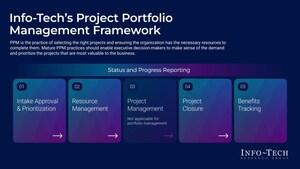Declining enrollment risks academic reputation through program, faculty, and student service cuts and can diminish educational quality and experience, the firm's latest research reveals.
TORONTO, June 6, 2023 /PRNewswire/ - The COVID-19 pandemic has shaken the foundations of conventional education systems, casting doubt on the value of tertiary education. Universities and colleges, which heavily rely on tuition fees, are experiencing a decrease in enrollment, raising a tangible risk of closure or consolidation. Adding to the challenges, governmental financial support for higher education – which is significantly dependent on student numbers – has remained largely unchanged over the past two decades. Aligning the IT department's efforts with the institution's need to increase competitive advantage is crucial, global IT research and advisory firm Info-Tech Research Group explains in newly published research, Understand the IT Implications for the Enrollment Cliff. The latest industry resource is intended to guide IT in helping higher education institutions navigate the enrollment cliff the industry is currently facing.
"The COVID-19 pandemic has also contributed to the enrollment cliff, as it has disrupted many traditional education models and raised concerns about the value of higher education," says Mark Maby, Research Director for Education at Info-Tech Research Group. "This decline poses a significant financial challenge for colleges and universities that rely on tuition revenue. The risk of closure and consolidation is very real."
Info-Tech's research shows that closures are becoming more prevalent due to increased competition, with more prestigious universities attracting students away from the less renowned ones. Alongside this trend, governments are encouraging consolidation between institutions as a means to save costs and support a changing demographic. As institutional leaders launch strategic initiatives to address the enrollment downturn, IT may find itself grappling with the resulting technology implications.
"The decline in enrollment in higher education is due to several factors, including declining birth rates, increasing tuition costs, and a strong job market that may incentivize young people to enter the workforce instead of pursuing higher education," explains Maby.
Info-Tech advises IT departments to take a proactive approach to effectively address the enrollment cliff. This involves developing a comprehensive plan that focuses on cost reduction through internal centralization efforts and external partnerships with other institutions. Additionally, it is crucial to assess the external context of the institution, conduct interviews with key stakeholders to understand their priorities, and determine how IT can support and enhance the institution's competitive advantage.
Some of the factors that higher educational institutions should consider to effectively navigate enrollment declines include the following, as outlined in the firm's new industry resource:
- Social Context: Not all regions are impacted equally; for example, the northeast US is being particularly hard hit. Demographic shifts are underway, marked by rising Hispanic and Asian student populations.
- Effects on Higher Education: A notable trend is the reduction and merging of higher education institutions. Flagship universities are extending their reach beyond their traditional student base to the detriment of other institutions.
- Response from Higher Education: Many higher education institutions are focusing on attracting international students and enhancing marketing and recruitment efforts. They are also expanding course offerings and collaborating with other universities and community colleges.
Given the decline in enrollment and potential institutional mergers or closures, Info-Tech recommends institutions should focus on the following factors to tackle enrollment cliff and improve the institution's attractiveness to new students.
Cost Reduction
- Internally: Reduce vendor spending and develop greater centralization.
- Externally: Create shared services between institutions.
Strategic Prioritization
- PESTLE Analysis: Conduct a PESTLE analysis to understand the context of a specific institution.
- Stakeholder Interviews: Interview stakeholders to know their enrollment priorities.
- Porter's Five Forces: Align IT initiatives to support the institution's competitive strategy.
- Power of Students: Strategic Enrollment
- Power of Suppliers: Faculty and Facilities
- Threat of New Entrants
- Threat of Substitution: Degree Alternatives
- Competitive Rivalry
Info-Tech's research further reveals that a decrease in enrollment can pose risks to an institution's academic reputation, as it may lead to cuts in programs, faculty, and student services. Such reductions in funding can negatively impact academic quality and the overall educational experience.
Download the Understand the IT Implications for the Enrollment Cliff blueprint to learn how IT can support higher educational institutes for a competitive edge.
For more information about Info-Tech Research Group or to access the latest research, visit infotech.com and connect via LinkedIn and Twitter.
Info-Tech Research Group is one of the world's leading information technology research and advisory firms, proudly serving over 30,000 IT professionals. The company produces unbiased and highly relevant research to help CIOs and IT leaders make strategic, timely, and well-informed decisions. For 25 years, Info-Tech has partnered closely with IT teams to provide them with everything they need, from actionable tools to analyst guidance, ensuring they deliver measurable results for their organizations.
Media professionals can register for unrestricted access to research across IT, HR, and software and over 200 IT and industry analysts through the firm's Media Insiders program. To gain access, contact [email protected].
SOURCE Info-Tech Research Group

WANT YOUR COMPANY'S NEWS FEATURED ON PRNEWSWIRE.COM?
Newsrooms &
Influencers
Digital Media
Outlets
Journalists
Opted In






Share this article